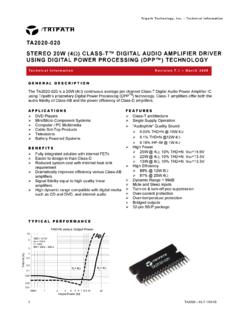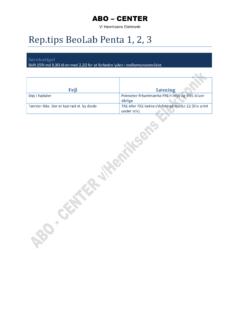Transcription of Measuring Loudspeakers, Part One - Troels Gravesen
1 Measuring Loudspeakers, part One John Atkinson, November 1998 This series of articles was initially written (in slightly different form), as a paper presented at the 103rd audio Engineering Society Convention, New York, September 1997. The preprint, "Loudspeakers: What Measurements Can Tell Us And What They Can't Tell Us!," AES Preprint 4608, is available from the AES, 60 East 42nd Street, Room 2520, New York, NY 10165-0075. The AES internet site, offers a secure transaction page for credit-card orders. What's the point of Measuring the performance of an audio component if what is owners do is listen to it? Of the 20 or so regularly published English-language consumer magazines on audio , only three routinely publish rigorous loudspeaker measurements: Hi-Fi News & Record Review in the UK; audio and Stereophile in the US (footnote 1). It would seem that supporting a reviewer's subjective impression of how a loudspeaker sounds with measured data is an idea that is out of fashion these days.
2 But without Measuring a loudspeaker 's performance, how can a "Golden Ears" reviewer avoid falling into error? I believe that it is the responsibility of any magazine that publishes judgments on audio components to fully describe their performance. And that cannot be done without measurements. For electronic components, Measuring their effect on an input signal is relatively straightforward (though correlating those effects with perceived sound quality is not a job for the fainthearted). But for many decades, getting a true idea of how a loudspeaker performed was only possible using swept sinewaves in large, expensive anechoic chambers. However, the relatively recent advent of low-cost, PC-based Measuring equipment capable of assessing acoustic performance in normal rooms has made it possible for more people to measure more loudspeakers than ever before.
3 However, simply placing a microphone in front of a loudspeaker and pressing ENTER on the computer keyboard will still not produce a measurement that is likely to predict how that loudspeaker will sound in a room. If you examine the vocabulary typically used to describe loudspeaker performance by audiophiles and in magazine reviews [1, 2, 3, 4], it covers the following areas: Musical and technical accuracy how good? How close is the loudspeaker to reproducing an overall sound that will convince its listeners they're in the presence of live sounds? Frequency range bass and treble extension. Does the sound have its full complement at the frequency extremes? Or has, say, the designer discarded ultimate bass extension, perhaps to maximize midrange clarity or overall power handling? Frequency balance how neutral? Does the speaker have a natural timbre?
4 If you play a recording of someone's voice, does it actually sound like that person's voice, or does it sound more like a combination of bass boom and a bat squeak? Is the presentation tilted-up at one or both frequency extremes? Is there a shelf effect present at one or more frequencies? Response and balance anomalies coloration. Do voices sound like someone is speaking through a megaphone or pinching their noses. Is there excessive sibilance on a female voice or too much chest tone on male voice?Can the sounds of similar but different musical instruments be distinguished? Or does the loudspeaker 's own character make a violin sound like a viola, an oboe like an English Horn, a Fender Stratocaster like a Gibson Les Paul? With some chronic loudspeaker cabinet problems, it can almost sound as though someone is banging a xylophone along with the sound of the recorded instruments.
5 Clarity and transparency. How much detail can you hear? I remember taking part in a blind test in the early '80s where we A/B'd two speakers using a live microphone feed of a bunch of keys being rattled in an anechoic chamber. One speaker made it sound like there was just one key. With another loudspeaker , you could almost hear how many keys there were. Do individual images within the soundstage sound sufficiently separate from each other, or do they seem more like spatial highlights emerging from a background of sonic soup? Grain, hardness, and distortion. Does the loudspeaker sound significantly more distorted at high playback levels? Does the loudspeaker make listeners want to run screaming from the room? Do the listeners feel as if their eardrums are being gently caressed with sandpaper? Stereo imaging precision. When a dual-mono recording is played, do listeners perceive a narrow sonic object precisely midway between the loudspeakers, or do they just hear a vague, amorphous blob?
6 Do central images stay centrally located at some frequencies but not others? Soundstage width and depth. With appropriate recordings, can listeners hear acoustic objects precisely positioned anywhere on a two-dimensional grid defined by the loudspeaker and listener positions? Dynamics (micro and macro). Are loud musical passages appropriately louder than the quiet passages (macrodynamics)? Can listeners hear subtle changes in one acoustic object when something else is playing very loudly (microdynamics)? Does it all blur at high playback levels, or does it take being played loudly to make the music "come to life"? Pace'n'rhythm. First defined by Stereophile contributor and UK reviewer Martin Colloms [5]. Some loudspeakers clearly make the music sound like it's going slowly, while others make it sound like it's going faster, even though the recording's playing time and the music's tempo obviously cannot be affected by anything that a loudspeaker does.
7 Footnote 1: Julian Hirsch published descriptions of how his review speakers measured throughout his tenure at Stereo Review, but as nary a graph was to be seen in that magazine's pages, I didn't feel it appropriate to include it in this list. However, with the policy changes announced in its September 1998 issue, Stereo Review would appear to be taking a step forward. Subjective loudspeaker performance is thus a multidimensional phenomenon. However, to make objective measurements that are both meaningful and practicable involves a subjective choice about what parameter to plot against one, or at most two, other parameters. All other parameters have then to be held constant. If you plot, say, a loudspeaker 's sound-pressure level against frequency for a given input voltage, the result is the typical amplitude or "frequency" response. But this measured response will only be valid on the chosen axis in an anechoic chamber at the chosen sound-pressure level at one instant of time.
8 How typical will it be of what the loudspeaker does with music in a real room played at widely differing spls? It is important, therefore, to keep in the back of your mind that to make "objective" measurements involves subjective choices! A list of measurements that I typically perform in connection with the loudspeaker reviews published in Stereophile includes: Voltage sensitivity on the chosen axis. Electrical impedance (magnitude and phase). Impulse and step responses. Amplitude and phase response on the chosen axis in the farfield. Nearfield amplitude response (at low frequencies). Polar behavior Dispersion in horizontal and vertical planes. Power and other in-room responses. Nonlinear distortions of various kinds. Delayed acoustic resonances. Cabinet vibrational behavior. It should be obvious that not one of the parameters in this second list appears to bear any direct correlation with one of the subjective attributes in the first list.
9 If, for example, an engineer needs to measure a loudspeaker 's perceived "transparency," there isn't any single two- or three-dimensional graph that can be plotted to show "objective" performance parameters that correlate with the subjective attribute. Everything a loudspeaker does affects it to some degree or other. Of course, there are some performance parameters that correlate significantly perceived bass extension with measured low-frequency extension, for example but it is important to remember that there will always be other aspects of measured performance that also contribute. Anyone who looks at published measurements should never assume that one measurement a frequency response, or an impedance curve, or a dispersion pattern fully or even partially describes the sound that they will hear. It's only the totality of all possible measurements looked at simultaneously that will give the reader any idea of what's going on.
10 What you hear always depends on more than one measurement. Ergo, no one measurement can tell the whole story. And given half a chance, all measurements will tell lies. It's very easy to assume that if you get a piece of test gear, turn it on, and hook it up to the device-under-test, that the resultant graph is meaningful. It's never safe to assume that a) the graph is correctly plotted, or b) that you are actually Measuring what you think you're Measuring . You still need another source of data, much as in pre-calculator days someone using a slide-rule needed to know approximately what the answer would be before they did a calculation. When you measure a loudspeaker 's complex impedance, for example, it is helpful to look at the waveform of the signal present at the speaker terminals with an oscilloscope and to listen to the speaker's acoustic output.




